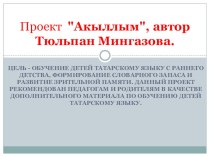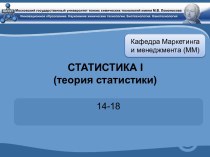- Главная
- Разное
- Бизнес и предпринимательство
- Образование
- Развлечения
- Государство
- Спорт
- Графика
- Культурология
- Еда и кулинария
- Лингвистика
- Религиоведение
- Черчение
- Физкультура
- ИЗО
- Психология
- Социология
- Английский язык
- Астрономия
- Алгебра
- Биология
- География
- Геометрия
- Детские презентации
- Информатика
- История
- Литература
- Маркетинг
- Математика
- Медицина
- Менеджмент
- Музыка
- МХК
- Немецкий язык
- ОБЖ
- Обществознание
- Окружающий мир
- Педагогика
- Русский язык
- Технология
- Физика
- Философия
- Химия
- Шаблоны, картинки для презентаций
- Экология
- Экономика
- Юриспруденция
Что такое findslide.org?
FindSlide.org - это сайт презентаций, докладов, шаблонов в формате PowerPoint.
Обратная связь
Email: Нажмите что бы посмотреть
Презентация на тему The invention of radio alexander popov
Содержание
- 2. RadioRadio - the first technical means, suitable
- 3. Alexander Stepanovich PopovAlexander Stepanovich Popov (1859-1906) -
- 4. The invention of radio AS PopovIn Russia,
- 5. principles of radioFor the implementation of radio
- 6. For the receiver of wireless telegraphy signs
- 7. Before traveling to Chicago Popov during the
- 8. Popov's invention of telegraphy without wires1890 Studying
- 9. Receiver that Popov demonstrated during the report, 12 (24) March 1896
- 10. Only then Popov reported his invention at
- 11. Later Popov further defended his priority in
- 12. Popov demonstrated the world's first reception of radiograms "Heinrich Hertz" 12 (24) March 1896.
- 13. PTO to award a diploma Popov Prize
- 14. The world's first practical radio link between
- 15. Fighting for PriorityPopov did not take a
- 16. Popov leading role in the invention of
- 17. Chief curator of the Central Museum of
- 18. In 1899, together with Popov and P.N.Rybkinym
- 19. Modern electronic devices broadcasting technology:TVs, receivers, cellular
- 20. Thank you for your attention
- 21. Скачать презентацию
- 22. Похожие презентации
RadioRadio - the first technical means, suitable for wireless communication, was born as a result of numerous scientific studies and technical research scientists and engineers.










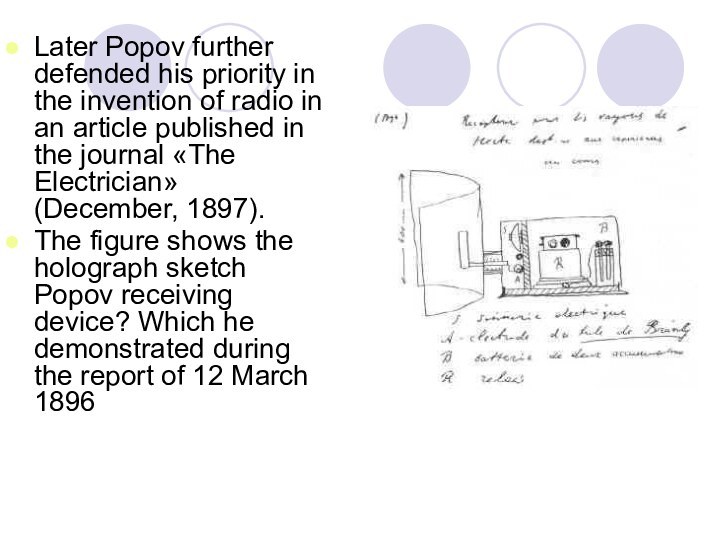






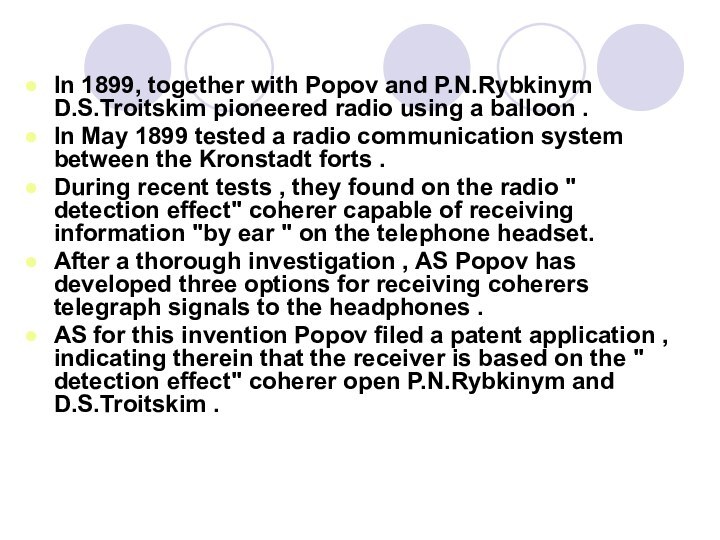


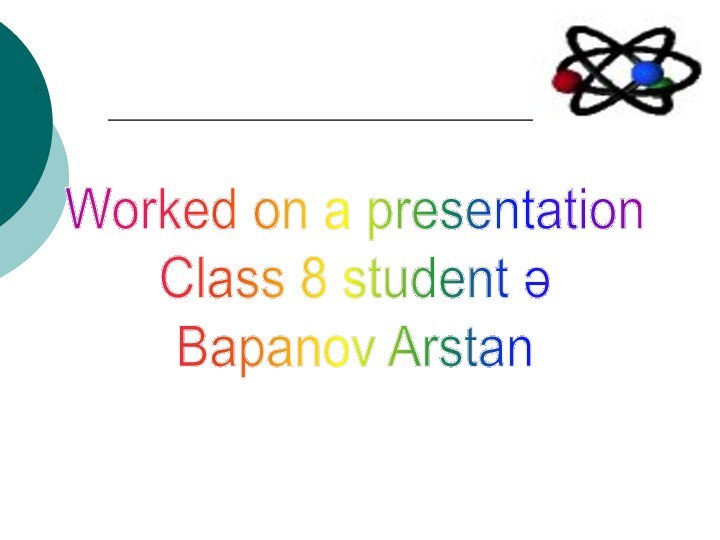
Слайд 3
Alexander Stepanovich Popov
Alexander Stepanovich Popov (1859-1906) - Russian
physicist, inventor of the radio. Convinced connectivity without wires
using electromagnetic waves, Popov built the world's first radio, using its sensor circuit - coherer. During experiments using radio devices Popova was first discovered radio waves reflected from the ships. Когерер
Слайд 4
The invention of radio AS Popov
In Russia, one
of the first engaged in the study of electromagnetic
waves teacher officer courses in Kronstadt Alexander Popov. In his radio as parts directly sentient electromagnetic waves, AS Popov used a coherer. What would improve the sensitivity of the device, one of the conclusions Popov coherer is grounded, and the other attached to a piece of wire held high, creating the first receiving antenna.
Слайд 5
principles of radio
For the implementation of radio communication
is necessary to use high-frequency oscillations. To transmit sound
these high-frequency oscillations modulated by a low frequency electrical oscillations. At the receiver, the same of the modulated high-frequency oscillations are allocated low-frequency oscillations. This conversion process is called signal detection.Слайд 6 For the receiver of wireless telegraphy signs of
functional fitness are:
1. Reliability;
2. Stability of admission;
3. Registering long and short signals;
4. Ease and economy of operation;
5. Sufficient sensitivity.
Слайд 7 Before traveling to Chicago Popov during the winter
1892-1893 gg. created a powerful transmitter for developed his
system of telegraphy without wires to the Navy of Russia.System of telegraphy without wires has been repeatedly tested in the spring of 1895 in the garden of mine officer class.
Слайд 8
Popov's invention of telegraphy without wires
1890 Studying and
repeating experiments G.Gertsa, Alexander Popov concluded that on the
basis of electromagnetic waves can create a new system of long-distance communication without wires to the Navy of Russia.?In 1893 in Chicago, opened the World Exhibition. Marine Technical Committee sent Popov to this exhibition as a specialist in the use of electricity.
Слайд 10 Only then Popov reported his invention at a
meeting of the physical separation of the Russian Physico-Chemical
Society (RFHO) April 25, 1895At this meeting he conducted the world's first radio communication with the transmission and reception of long and short signals - Morse code elements - and their fixation call receiver.
The figure shows the world's first radio that Popov demonstrated at a meeting of the physical separation RFHO April 25 (May 7) 1895
Слайд 11 Later Popov further defended his priority in the
invention of radio in an article published in the
journal «The Electrician» (December, 1897).The figure shows the holograph sketch Popov receiving device? Which he demonstrated during the report of 12 March 1896
Слайд 12 Popov demonstrated the world's first reception of radiograms
"Heinrich Hertz" 12 (24) March 1896.
Слайд 13 PTO to award a diploma Popov Prize Sovereign
Tsarevich for the invention of telegraphy without wires, November
30, 1898Слайд 14 The world's first practical radio link between the
islands Kutsalo Popov and Hogland (telephone receiver Popov, which
obtained Russian privilege, as well as French and English patents (upper left image, on the radio on. Hogland (lower left picture))
Слайд 15
Fighting for Priority
Popov did not take a patent,
but under Russian law may be regarded as the
inventor, since revealed the essence of your device for a wide range of people to play with sufficient detail.Important question that arises in the ensuing discussion, the priority - the kind of device invented Popov: receiver or system radiosignalizatsii.
Слайд 16 Popov leading role in the invention of radio
was highly appreciated by the Board of Ministers -
Government of the Russian Federation dated 11 May 1993 for the number 434 "On the preparation and conduct of the 100th anniversary of the invention of radio ." The resolution notes the leading role of this event in modern civilization , and the priority of the Russian scientist , Professor Popov .This anniversary date was included in the UNESCO calendar of anniversaries and events. Under the auspices of 5-7 May 1995 in Moscow International Anniversary Conference dedicated to the 100th anniversary of the invention of radio .
Слайд 17 Chief curator of the Central Museum of Communications
them . Popov in St. Petersburg V.K.Marchenkov in the
journal " Telecommunications " on the basis of archival documents and layouts substantiated list of inventions Popov :- A system of telegraphy without wires , radio system , in May 1895 ; ? - Instrument meteorological purposes " razryadootmetchik Popov - storm indicator ", June 1895 ; ? - Phone radio, November 1899 ; ? - Self-healing phone coherer , January 1900 ; ? - Spark radio system (with docent S.Ya.Livshitsem ) , January 1903
Слайд 18 In 1899, together with Popov and P.N.Rybkinym D.S.Troitskim
pioneered radio using a balloon .
In May 1899 tested
a radio communication system between the Kronstadt forts .During recent tests , they found on the radio " detection effect" coherer capable of receiving information "by ear " on the telephone headset.
After a thorough investigation , AS Popov has developed three options for receiving coherers telegraph signals to the headphones .
AS for this invention Popov filed a patent application , indicating therein that the receiver is based on the " detection effect" coherer open P.N.Rybkinym and D.S.Troitskim .
Слайд 19
Modern electronic devices broadcasting technology:
TVs, receivers, cellular radio
telephone, tape recorders, computers, MP3 players,. Kv.i VHF transmitter
systems.From the old technology of radio parts and products. Modern base elements can assemble products in weight. In dimensions. At some times to reduce the dimensions of the product and also reduce power consumption. What gives you the opportunity to make products cost-effectively.
